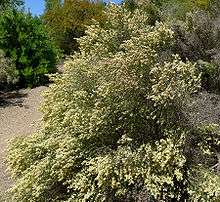Baccharis
Baccharis /ˈbækərɪs/[3] is a genus of perennials and shrubs in the aster family (Asteraceae). They are commonly known as baccharises but sometimes referred to as "brooms", because many members have small thin leaves resembling the true brooms. They are not at all related to these however, but belong to an entirely different lineage of eudicots. B. halimifolia is commonly known as "groundsel bush", however true groundsels are found in the genus Senecio.
| Baccharis | |
|---|---|
 | |
| Flowering Baccharis articulata | |
| Scientific classification | |
| Kingdom: | Plantae |
| Clade: | Tracheophytes |
| Clade: | Angiosperms |
| Clade: | Eudicots |
| Clade: | Asterids |
| Order: | Asterales |
| Family: | Asteraceae |
| Subfamily: | Asteroideae |
| Supertribe: | Asterodae |
| Tribe: | Astereae |
| Genus: | Baccharis L.[1] |
| Species | |
|
Some 250-400, see text | |
| Synonyms | |
|
Achyrobaccharis Sch.Bip. ex Walp. | |
Baccharis, with over 500 species, is the largest genus in the Compositae.[4] It is found throughout the Americas, distributed mainly in the warmer regions of Brazil, Argentina, Colombia, Chile and Mexico,[5] with B. halimifolia ranging northward along the Atlantic Coast to the southern tip of Nova Scotia in Canada.[6]
If present, the leaves of Baccharis are borne along the stems in alternate fashion. Flowers are usually white or pinkish. There are no ray flowers, but many disk flowers which are either staminate or pistillate.
Some species of Baccharis are toxic to animals; in particular, consumption of B. coridifolia may lead to necrosis in the gastrointestinal tract of cattle, horses, sheep, and rabbits.
Classification
Baccharis is related to the genera Archibaccharis and Heterothalamus.[7]
The genus Baccharis is named after Bacchus (Dionysus), the Roman god of wine.
Ecology
Baccharis are used as food plants by the larvae of some Lepidoptera species, such as the swift moths Phymatopus californicus and P. hectoides. Those of the leaf-miner moths Bucculatrix dominatrix and B. seperabilis feed exclusively on Bush Baccharis (B. pilularis), B. ivella has been found on Eastern Baccharis, and B. variabilis is a polyphagous species which has been recorded on various Baccharis. The Coleophora case-bearers C. linosyridella and C. viscidiflorella are polyphagous species whose larve have been recorded on the Bush Baccharis as well as other plants. Caterpillars of the owlet moth Schinia ocularis feed exclusively on Broom Baccharis (B. sarothroides).
Uses
Several species of Baccharis are of interest for cultivation, as the dense but flexible stem structure makes for a good windbreak.
Plants of this genus are rich in terpenes, and some are used in native or folk medicine. One that has been specifically described from Chilean and Argentinean Baccharis is viscidone.
Baccharis flowers are rich in nectar, and several species are good honey plants. Particularly B. dracunculifolia is highly esteemed by beekeepers.
Conservation
A few Baccharis species (especially from the northern Andes) are almost extinct due to habitat destruction. The northernmost occurrence of B. halimifolia, in Nova Scotia, Canada, is also receiving conservation attention.[6]
Invasiveness
Some Baccharis species, particularly Eastern baccharis (B. halimifolia), have become invasive weeds in places such as Australia and Spain, where they are not native..
Selected species
For the complete list of species see List of Baccharis species.

|
|
Formerly placed in Baccharis
The following species are among the many that were considered to belong within Baccharis but are now classified in other genera:
- Isocoma veneta (Kunth) Greene (as B. veneta Kunth)
- Pluchea foetida (L.) DC. (as B. foetida L.)
- Pluchea indica (L.) Less. (as B. indica L.)
- Ozothamnus hookeri Sond. (as B. lepidophylla DC.)
- Vernonanthura brasiliana (L.) H.Rob. (as B. brasiliana L.)
- Vernonanthura montevidensis (Spreng.) H.Rob. (as B. montevidensis Spreng.)[8]
References
| Wikimedia Commons has media related to Baccharis. |
| Wikispecies has information related to Baccharis |
- Linnaeus 1753, p. 860.
- "Genus: Baccharis L." Germplasm Resources Information Network. United States Department of Agriculture. 2007-10-05. Retrieved 2010-12-11.
- Sunset Western Garden Book, 1995:606–607
- Senecio, formerly considered the largest genus of the family, is now divided into a number of genera, each with fewer species than Baccharis.
- http://www.arkat-usa.org/get-file/19602/ Baccharis (Compositae) - Maria José Abad* and Paulina Bermejo
- "Species at Risk Conservation Fund 2009 Approved Projects:". Nova Scotia Canada Department of Natural Resources. Retrieved 11 October 2011.
- "Baccharis Linnaeus". Flora of North America.
- "GRIN Species Records of Baccharis". Germplasm Resources Information Network. United States Department of Agriculture. Retrieved 2010-12-11.
Bibliography
External links
- Pictures of Baccharis rhomboidalis, Baccharis sagittalis and Baccharis sphaerocephala growing in Chile.
- "Baccharis". Integrated Taxonomic Information System.